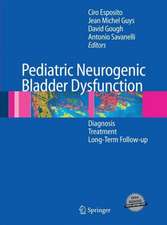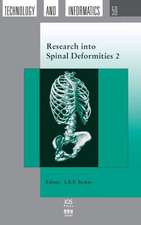Atypical Breast Proliferative Lesions and Benign Breast Disease
Editat de Farin Amersi, Kristine Calhounen Limba Engleză Paperback – 19 ian 2019
This text will provide a concise but comprehensive summary of the current management of patients with atypical breast proliferative lesions and some benign breast lesions and will help guided management of these patients. All chapters in this text will be written by experts in the field in each of these disease entities. They will all include the most up to date research and clinical information to enhance our understanding and treatment of patients.
| Toate formatele și edițiile | Preț | Express |
|---|---|---|
| Paperback (1) | 424.94 lei 38-44 zile | |
| Springer International Publishing – 19 ian 2019 | 424.94 lei 38-44 zile | |
| Hardback (1) | 597.27 lei 38-44 zile | |
| Springer International Publishing – 10 oct 2018 | 597.27 lei 38-44 zile |
Preț: 424.94 lei
Preț vechi: 447.30 lei
-5% Nou
Puncte Express: 637
Preț estimativ în valută:
81.31€ • 85.12$ • 67.28£
81.31€ • 85.12$ • 67.28£
Carte tipărită la comandă
Livrare economică 01-07 aprilie
Preluare comenzi: 021 569.72.76
Specificații
ISBN-13: 9783030064822
ISBN-10: 3030064824
Pagini: 197
Ilustrații: XI, 197 p. 28 illus., 24 illus. in color.
Dimensiuni: 155 x 235 mm
Ediția:2018
Editura: Springer International Publishing
Colecția Springer
Locul publicării:Cham, Switzerland
ISBN-10: 3030064824
Pagini: 197
Ilustrații: XI, 197 p. 28 illus., 24 illus. in color.
Dimensiuni: 155 x 235 mm
Ediția:2018
Editura: Springer International Publishing
Colecția Springer
Locul publicării:Cham, Switzerland
Cuprins
The Spectrum of Risk Lesions in Breast Pathology: Risk Factors or Cancer Precursors?.- Lobular Carcinoma In Situ: Risk Factor or Cancer Precursor?.- Ductal Carcinoma In Situ: Risk Factor or Cancer.- Diagnostic Management of Papillomas, Radial Scars, and Flat Epithelial Atypia: Core Biopsy Alone Versus Core Biopsy Plus Excision.- Diagnostic Management of Fibroepithelial Lesions: When Is Excision Indicated?.- Diagnostic Management of the Atypical Hyperplasias: Core Biopsy Alone vs Excisional Biopsy.- Diagnostic management of LCIS: Core biopsy alone versus core biopsy plus excision for classic versus pleomorphic LCIS.- Breast Cancer Risk Prediction in Women with Atypical Breast Lesions.- Advanced Screening Options and Surveillance in Women with Atypical Breast Lesions.- The Role of Chemoprevention in the Prevention of Breast Cancer.- Prophylactic Mastectomy in Patients with Atypical Breast Lesions.- The Non-surgical Management of Ductal Carcinoma in Situ (DCIS).- Surgical Treatment of Ductal Carcinoma in Situ.
Notă biografică
Farin Amersi, MD
Associate Professor of Surgery
Cedars-Sinai Medical Center
Samuel Oschin Comprehensive Cancer Institute
8700 Beverly Blvd, #AC1046A
Los Angeles, CA, 90048, USA
Associate Professor of Surgery
Cedars-Sinai Medical Center
Samuel Oschin Comprehensive Cancer Institute
8700 Beverly Blvd, #AC1046A
Los Angeles, CA, 90048, USA
Kristine Calhoun, MD
Associate Professor of Surgery
University of Washington School of Medicine
Associate Director, Breast Health Clinic, Seattle Cancer Care Alliance
1959 NE Pacific Street, Box 356410
Seattle, WA, 98195, USA
Associate Professor of Surgery
University of Washington School of Medicine
Associate Director, Breast Health Clinic, Seattle Cancer Care Alliance
1959 NE Pacific Street, Box 356410
Seattle, WA, 98195, USA
Textul de pe ultima copertă
The days of surgical excision for any atypical lesion have been replaced by more nuanced decision making and individualized patient management. Current management of many of these lesions continues to be controversial in regard to observation with close surveillance versus the need for surgical excision of these lesions based on future risk or whether these lesions are precursor lesion.
The goal of this book is to provide a concise but comprehensive review of atypical breast proliferative lesions and their management complexities. New data about breast cancer, risk factors for breast cancer, pathological features unique to each entity, the characteristic findings on imaging, risk stratification for genetic testing, as well as the current evidence-based management of each of these breast lesions are discussed in full detail. Assessment tools for risk prediction of breast cancer are also highlighted as chapters run the gamut of current imaging modalities, as well as advanced screening options available for diagnosis and following these patients.
Atypical Breast Proliferative Lesions and Benign Breast Disease will undoubtedly become a valuable resource for nurse practitioners, physician assistants, breast and surgical oncology fellows, genetic counselors, geneticists, as well as other clinicians and surgeons who are referred and manage these complex breast patients. All chapters in this text are written by experts in the field who have research and clinical interest in each of these disease entities, and include the most up-to-date research and clinical information to enhance our understanding and treatment of patients.
The goal of this book is to provide a concise but comprehensive review of atypical breast proliferative lesions and their management complexities. New data about breast cancer, risk factors for breast cancer, pathological features unique to each entity, the characteristic findings on imaging, risk stratification for genetic testing, as well as the current evidence-based management of each of these breast lesions are discussed in full detail. Assessment tools for risk prediction of breast cancer are also highlighted as chapters run the gamut of current imaging modalities, as well as advanced screening options available for diagnosis and following these patients.
Atypical Breast Proliferative Lesions and Benign Breast Disease will undoubtedly become a valuable resource for nurse practitioners, physician assistants, breast and surgical oncology fellows, genetic counselors, geneticists, as well as other clinicians and surgeons who are referred and manage these complex breast patients. All chapters in this text are written by experts in the field who have research and clinical interest in each of these disease entities, and include the most up-to-date research and clinical information to enhance our understanding and treatment of patients.
Caracteristici
P?rovides a concise, but comprehensive summary of the current management of patients with atypical breast proliferative lesions Written by experts in the field Supplies assessment tools for risk prediction of breast cancer













